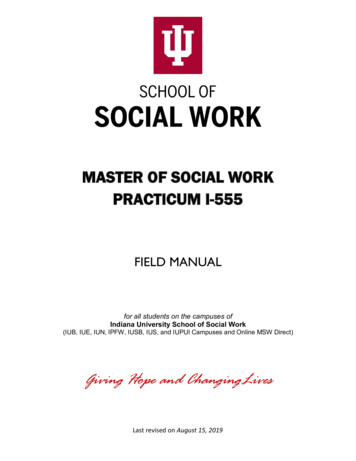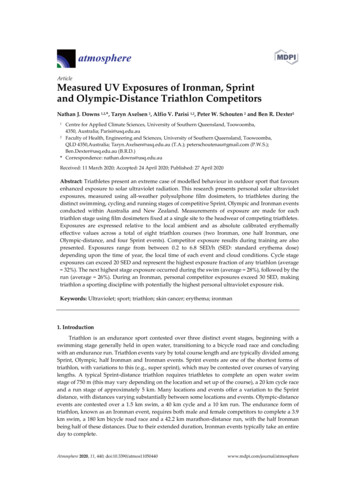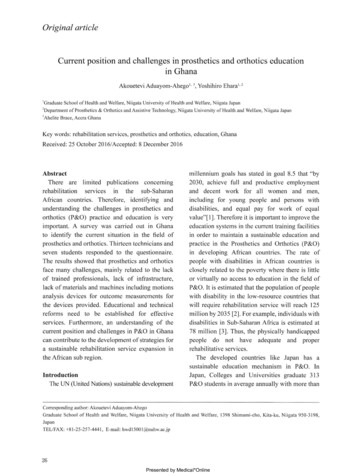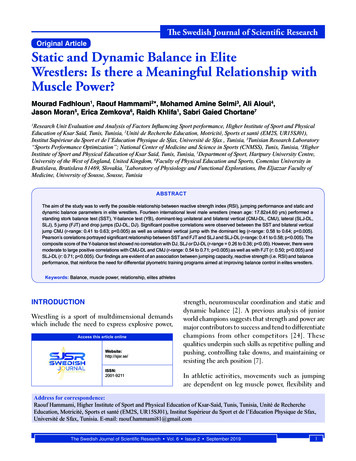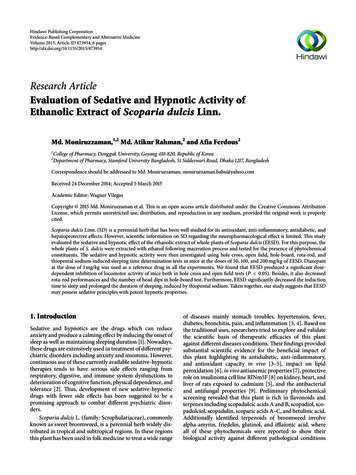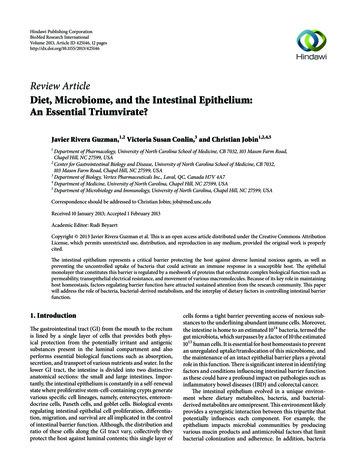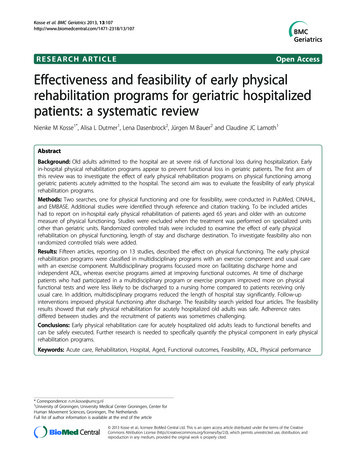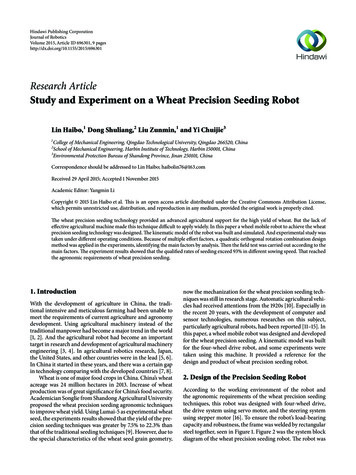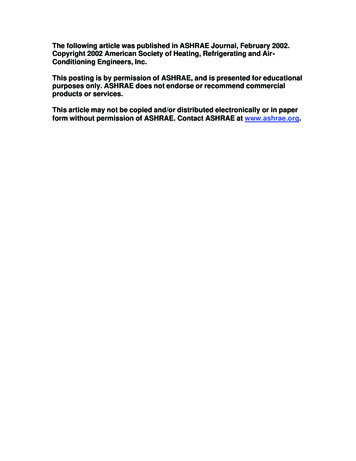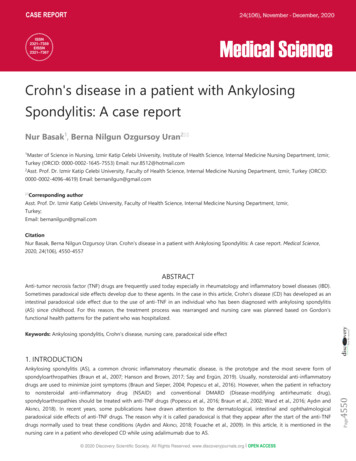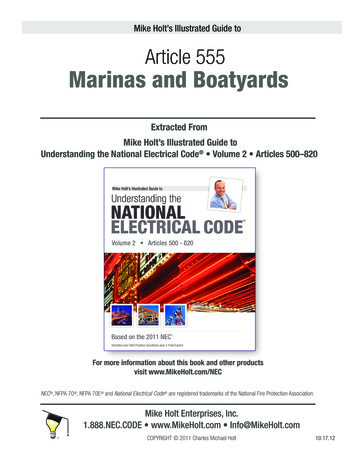
Transcription
Mike Holt’s Illustrated Guide toArticle 555Marinas and BoatyardsExtracted FromMike Holt’s Illustrated Guide toUnderstanding the National Electrical Code Volume 2 Articles 500–820For more information about this book and other productsvisit www.MikeHolt.com/NECNEC , NFPA 70 , NFPA 70E and National Electrical Code are registered trademarks of the National Fire Protection Association.Mike Holt Enterprises, Inc.1.888.NEC.CODE www.MikeHolt.com Info@MikeHolt.comCOPYRIGHT 2011 Charles Michael Holt10.17.12
ARTICLE555Marinas and BoatyardsIntroduction to Article 555—Marinas and BoatyardsWater level isn’t constant. Ocean tides rise and fall, while lakes and rivers vary in depth in response to rain. To provide power to a marina orboatyard, you must allow for these variations in water level between the point of use and the power source. Article 555 addresses this issue.This article begins with the concept of the electrical datum plane. You might think of it as the border of a “demilitarized zone” for electricalequipment. Or, you can think of it as a line that marks the beginning of a “no man’s land” where you simply don’t place electrical equipment.Once you determine where this plane is, don’t locate transformers, connections, or receptacles below that line.555.1 Scope. Article 555 covers the installation of wiring andequipment for fixed or floating piers, wharfs, docks, and other areasin marinas, boatyards, boat basins, boathouses, and similar occupancies. This article doesn’t apply to docking facilities or boathousesused for the owners of single-family dwellings.Author’s Comment: GFCI protection is required for outdoor15A and 20A, 125V receptacles [210.8].555.2 Definitions.Electrical Datum Plane.(1) Land Area Subject to Tidal Fluctuation. The horizontal plane 2 ftabove the highest high tide that occurs under normal circumstances.Figure 555–1(2) Land Areas Not Subject to Tidal Fluctuation. The horizontalplane 2 ft above the highest water level that occurs under normalcircumstances.(3) Floating Piers. The horizontal plane 30 in. above the water level atthe floating pier and a minimum of 12 in. above the level of the deck.Author’s Comment: This definition is necessary for the location of transformers [555.5], electrical connections [555.9], andreceptacles [555.19] near water.Marine Power Outlet. An assembly that can include equipment suchas receptacles, circuit breakers, fused switches, fuses, watt-hourmeters, and distribution panelboards for marine use.Figure 555–1Author’s Comment: This definition is necessary for theapplication of shore power receptacles [555.19(A)(1)] and disconnecting means [555.17(B)].555.3 Ground-Fault Protection. The overcurrent protectivedevice for the main marina feeder conductors must have ground-faultprotection not exceeding 100 mA. If ground-fault protection is provided for each individual marina branch or feeder circuit, ground-faultprotection isn’t required for the main marina feeder conductors.555.5 Transformers. Transformers must be approved by theauthority having jurisdiction for the location, and the bottom must notbe located below the electrical datum plane.Mike Holt Enterprises, Inc. www.MikeHolt.com 888.NEC.CODE (632.2633)1
Marinas and Boatyards555.7 Location of Service Equipment. Service equip ment for floating docks or marinas isn’t permitted to be located on thefloating structure.Fixed Piers. For a fixed pier, electrical connections must be locatednot less than 12 in. above the deck, and never below the electricaldatum plane. Figure 555–4555.9 Electrical Connections.Floating Piers. Electrical connections must be located not less than12 in. above the deck of a floating pier, unless the conductor splicesare contained within approved junction boxes utilizing sealed wireconnector systems listed and identified for submersion located abovethe waterline but below the electrical datum plane for floating piers.Figures 555–2 and 555–3Figure 555–4555.10 Electrical Equipment Enclosures.(A) Securing and Supporting. Electrical equipment en closures mustbe se curely and substantially supported by structural members, independent of any raceway connected to them.Figure 555–2(B) Location. Electrical equipment enclosures on piers must belocated so as not to interfere with mooring lines.555.12 Load Calculations for Service and FeederConductors. The calculated ungrounded and neutral service orfeeder load for shore power receptacles can be calculated using theadjustment factors contained in Table 555.12.Figure 555–3Mike Holt Enterprises, Inc. www.MikeHolt.com 888.NEC.CODE (632.2633)2
Marinas and BoatyardsTable 555.12 Adjustment FactorsQuestion: What size 120/240V, single-phase service is requiredfor a marina with twenty 20A, 125V receptacles, and twenty30A, 250V receptacles? Figure 555–6Number of ReceptaclesSum of the Rating ofthe Receptacles1–4100%(a) 200A5–890%Answer: (c) 600A9–1480%Step 1: Determine the receptacle load per line.15–3070%31–4060%41–5050%51–7040%Over 7130%Note 1. If shore power provides two receptacles having different voltages for anindividual boat slip, only the receptacle with the larger kilowatt demand rating isrequired to be included in the calculation. Figure 555–5Figure 555–5(b) 400ATwenty 20A, 125V(c) 600A(d) 800ALine 1Line 2200A200A (ten each line)Twenty 30A, 250V 600A 600A (twenty each line)800A800AStep 2: The calculated load per line for the marina is based onthe demand factor listed in Table 555.12 for 30 receptacles (per line). 800A x 0.70 560AFigure 555–6555.13 Wiring Methods and Installation.(A) Wiring Methods.(1) General. Any Chapter 3 wiring method identified for use in wetlocations.(2) Portable Power Cables. Sunlight resistance extra-hard usageportable power cables listed for wet locations having an outer jacketresistant to temperature extremes, oil, gasoline, ozone, abrasion,acids, and chemicals.Mike Holt Enterprises, Inc. www.MikeHolt.com 888.NEC.CODE (632.2633)3
Marinas and Boatyards(B) Installation.(4) Portable Power Cables.(a) Portable power cables permitted by 555.13(A)(2) must be:(1) Supported.(2) Located on the underside of the pier.(3) Securely fastened by nonmetallic clips to structural membersother than the deck planking.(4) Not be subject to physical damage.(5) Protected against chafing by a permanently installed oversizedsleeve of nonmetallic material when cables pass through structural members.(5) Protection. Raceway must be used to protect wiring above decksof piers and landing stages.Figure 555–7555.15 Grounding.(B) Equipment Grounding Conductor. An insulated copper equipment grounding conductor is required for circuits.(C) Size of Equipment Grounding Conductor. The insulated copperequipment grounding conductor must be sized in accordance with250.122, but not smaller than 12 AWG.555.17 Boat Receptacle Disconnecting Means. Adisconnecting means must isolate each boat from its shore powerreceptacle.(A) Type of Disconnect. A circuit breaker or switch must be used toserve as the required shore power receptacle disconnecting meansand it must be identified as to which receptacle it controls. Figure555–7(B) Location. The disconnecting means for shore power receptaclesmust be readily accessible and located not more than 30 in. from thereceptacle. Circuit breakers or switches located in marine power outlets can be used for the boat receptacle disconnecting means. Figure555–8Author’s Comment: This shore power receptacle disconnecting means is intended to eliminate the hazard of someoneengaging or disengaging the boat’s shore power attachmentplug with wet, slippery hands, and possibly contacting energizedblades. The “30-in. requirement” helps someone not familiarwith the marina layout to quickly reach the disconnecting meansin an emergency.Figure 555–8555.19 Receptacles. Receptacles must be mounted not lessthan 12 in. above the deck surface, and not below the electricaldatum plane. Figure 555–9(A) Shore Power Receptacles.(1) Enclosures. Receptacles intended to supply shore power to boatsmust be part of a listed marina power outlet enclosure, be installedin listed enclosures protected from the weather, or in listed weatherproof enclosures. The assembly must not be affected when the receptacles are in use with a booted or nonbooted attachment plug/capinserted.Mike Holt Enterprises, Inc. www.MikeHolt.com 888.NEC.CODE (632.2633)4
Marinas and Boatyards(b) Receptacles rated 60A or 100A must be of the pin and sleevetype.Author’s Comment: The rating of the shore power receptacledoesn’t depend upon the length of the boat. The Code simplysets a minimum rating of 30A and leaves it up to the designerand/or owner to provide the receptacles they deem necessarybased on the projected usage of the slips.(B) Other Than Shore Power.(1) GFCI Protection of Receptacles. 15A and 20A, 125V receptaclesinstalled outdoors, in boathouses, buildings/structures used for storage, maintenance, or repair for portable electric hand tools, electricaldiagnostic equipment, or portable lighting equipment must be GFCIprotected. Figure 555–11Figure 555–9(3) Branch Circuits. An individual branch circuit of the voltage classand rating corresponding to the rating of the receptacle must supplyeach receptacle that supplies shore power to boats.Note: Supplying 120/240V 3-wire receptacles from a 120/208V 3-wiresupply may cause overheating or malfunctioning of connected equipment.(4) Ratings. Receptacles that provide shore power for boats must berated not less than 30A.(a) Receptacles rated 30A and 50A must be of the locking andgrounding type. Figure 555–10Figure 555–11555.21 Motor Fuel Dispensing Stations—Hazardous(Classified) Locations.(A) General. Electrical wiring and equipment located at or servingmotor fuel dispensing equipment located on shore must comply withArticle 514. The determination of Class I, Division 1 and 2 areas formotor fuel dispensing on floating or fixed docks or piers must complywith 555.21(B). All electrical wiring for power and lighting must beinstalled on the side of the wharf, pier, or dock opposite from theliquid piping system.Figure 555–10Mike Holt Enterprises, Inc. www.MikeHolt.com 888.NEC.CODE (632.2633)5
Marinas and Boatyards555.22 Repair Facilities. Electrical wiring and equipment atmarine craft repair facilities containing flammable or combustible liquids or gases must comply with Article 511. Figure 555–12Author’s Comment: Important rules in Article 511 to considerinclude: 511.3 Classification of Hazardous Areas 511.4 Wiring and Equipment in Hazardous (Classified) Locations 511.7 Wiring and Equipment Above Hazardous (Classified)Locations 511.9 Explosionproof Seals 511.12 GFCI-Protected ReceptaclesFigure 555–12Mike Holt Enterprises, Inc. www.MikeHolt.com 888.NEC.CODE (632.2633)6
ARTICLE555Practice QuestionsPlease use the 2011 Code book to answerthe following questions.1.6.A is an enclosed assembly that can include receptacles, circuit breakers, fused switches, fuses, watt-hourmeter(s), distribution panelboards and monitoring meansapproved for marine use.At marinas and boatyards, the electrical datum plane, in landareas subject to tidal fluctuation, is a horizontal planeabove the highest high tide under normal circumstances.7.Electrical connections in marinas and boatyards shall belocated unless the conductor splices are containedwithin sealed wire connector systems listed and identified forsubmersion.(a) at least 12 in. above the deck of a floating pier(b) at least 12 in. above the deck of a fixed pier(c) not below the electrical datum plane of a fixed pier(d) all of these8.(a) 1 ft(b) 2 ft(c) 3 ft(d) 4 ft4.Service equipment for floating docks or marinas shall belocated the floating structure.(a) adjacent to(b) on(c) in(d) any of these(a) marine power receptacle(b) marine outlet(c) marine power outlet(d) any of these3.In marinas and boatyards, the bottom of enclosures for transformers shall not be located below .(a) 2 ft above the dock(b) 18 in. above the electrical datum plane(c) the electrical datum plane(d) a dockPrivate, noncommercial docking facilities constructed oroccupied for the use of the owner or residents of the associated are not covered by Article 555.(a) single-family dwelling(b) multifamily dwelling(c) a or b(d) none of these2.5.Electrical equipment enclosures at marinas must be securelyand substantially supported by structural members, independent of any raceway connected to them.(a) True(b) FalseThe overcurrent protective device for the main marina feederconductors must have ground-fault protection not exceeding. If ground-fault protection is provided for each individual marina branch or feeder circuit, ground-fault protectionis not required for the main marina feeder conductors.9.Equipment enclosures on piers must be located so as not tointerfere with mooring lines.(a) True(b) False(a) 6 mA(b) 20 mA(c) 30 mA(d) 100 mAMike Holt Enterprises, Inc. www.MikeHolt.com 888.NEC.CODE (632.2633)7
Marinas and Boatyards10.The demand factor for marina load calculations of 45 shorepower receptacles is percent.15.(a) 40(b) 50(c) 60(d) 7011.(a) accessible(b) readily accessible(c) remote(d) any of theseWhere shore power accommodations provide two receptaclesspecifically for an individual boat slip, and these receptacleshave different voltages, only the receptacle with theshall be required to be calculated.16.17.13.The equipment grounding conductor at a marina is required tobe an insulated copper conductor for all circuits.Supplying 120/240V 3-wire shore power receptacles from a120/208V 3-wire supply may cause overheating or malfunctioning of connected equipment.(a) True(b) False(a) True(b) FalseDisconnecting means shall be provided to each boatfrom its supply connection(s). The disconnecting means shallconsist of a circuit breaker, switch, or both, and shall identifywhich receptacle it controls.(a) isolate(b) separate(
NEC , NFPA 70 , NFPA 70E and . Please use the 2011 Code book to answer the following questions. 1. Private, noncommercial docking facilities constructed or occupied for the use of the owner or residents of the associ-ated _ are not covered by Article 555. (a) single-family dwelling (b) multifamily dwelling (c) a or b (d) none of these 2. A _ is an enclosed assembly that can .
